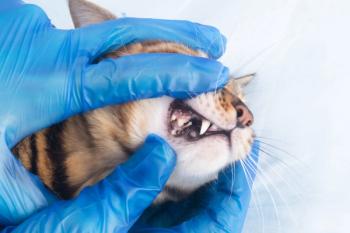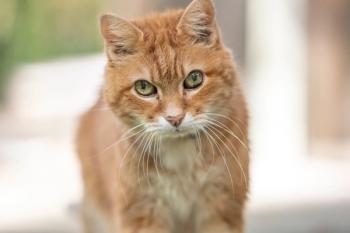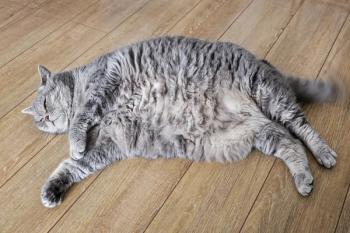
Feline CKD therapeutic goals: Do not throw away your shot
When it comes to therapeutic goals in managing chronic kidney disease in cats, the target has moved. Are you hitting it?
Are you on target with CKD treatment in cats? Photo: Shutterstock.comWhen managing cats with chronic kidney disease (CKD), yes, you still monitor and manage azotemia, blood pressure and urine protein, but there's a whole new realm of client-centered care that dictates how you set your goals. These days, quality of life and maintaining the human-animal bond are the primary focus.
In real life, this looks like:
Ensuring normal interactions with the family
Ensuring normal day-to-day behavioral patterns
Providing pain management
Avoiding polypharmacy (see “The fallacy of polypharmacy in CKD”).
The fallacy of polypharmacy in CKD
Polypharmacy describes the use of many drugs at the same time to treat one condition. Just because you can prescribe more medication to manage CKD doesn't mean you should, Dr. St. Denis says. This is because prescribing multiple medications may interfere with your primary therapeutic goals of maintaining the client-cat bond and quality of life. Pick treatments based on evidence-based medicine and known outcomes and those the client is willing to give. Avoid empirical treatments. Before adding a medication into a CKD cat's daily regimen, ask the client, “How do you feel about this? How are you doing with your medicating?” When you're working with a client to design a treatment plan for their CKD kitty, talk less and listen more.
Advice from
Therapy-don't be like Aaron Burr and wait for it
Early intervention is key, Dr. St. Denis says, and starting conversations about therapy when cats are in the early stages of CKD (
This is also a good time to plant the seeds about regular follow-up and explain that it's important to track changes over time. These simple conversations will help guide your client and avoid overwhelming them, which erodes the human-animal bond.
Early CKD is also a good time to talk about doing some additional diagnostics to determine if there's identifiable disease that can be treated, such as imaging to look for kidney stones or urine cultures to look for chronic infection, says Dr. St. Denis. If there are money constraints, then you can plan to test over time to help soften the financial impact. Utilize the phrase “If not today, how about next month?” to direct your client's actions.
Therapeutic kidney diets-they get the job done
The most important thing to ponder about nutrition in feline CKD is whether the cat is eating enough, Dr. St. Denis says. This is more important than what the cat is eating. Maintaining adequate caloric intake and muscle mass is critical to avoid protein malnutrition. But, as you already know, ensuring adequate intake in a cat can be very challenging. Working with the client and providing education in this area is an important therapeutic strategy. If the cat isn't eating enough or is underweight, then Dr. St. Denis recommends feeding 1.2 to 1.4 times the resting energy requirement (RER). Most geriatric cats need at least 1.1 times RER.
We all know that switching diets on a CKD cat that's experiencing decreased appetite can be challenging (understatement of the century). Dr. St. Denis recommends changing the diet earlier rather than later. Cats with CKD should be eating a diet that contains restricted phosphorus and highly digestible protein that meets or exceeds minimum standards. A therapeutic kidney diet that meets protein needs and contains complete amino acid profiles, plus omega-3 fatty acids, which have renal protective properties, will help ensure that your clients' cats will get everything they need.
Old, scrappy and not hungry
If your CKD patient isn't eating, determine if the inappetence or nausea is due to a contributing disease, dehydration or azotemia and treat that first, Dr. St. Denis says, before starting appetite stimulants. Maropitant is safe to use in cats with CKD, and it's labeled for oral, subcutaneous and intravenous administration. Ondansetron is also effective for nausea, either orally or intravenously. Mirtazapine also works well for nausea and inappetence. If the cat won't eat or is severely malnourished, don't hesitate to place a feeding tube to ensure caloric intake and medication administration.
What about uremic gastritis and ulcers? Historically, we prescribed antacids in CKD cats to prevent gastritis, but a new study has found that cats with CKD may not have elevated stomach acidity as compared with healthy cats.1 Dr. St. Denis hypothesizes that the inappetence associated with uremia is more likely due to chemoreceptors in the brain and less likely to be associated with elevated gastric acidity, making antacid treatment in cats with CKD less likely to help with nausea and inappetence. Avoid polypharmacy! Don't reach for the antacid unless you are seeing melena or bloody vomitus.
If nausea is under control, then appetite stimulants are helpful. In fact, the FDA recently approved a
Pain management-the world turned upside down
When I graduated from vet school, we didn't automatically associate pain with feline CKD, but now we know that these cats are hiding pain, due not only to CKD but also to occult degenerative joint disease (DJD), which is prevalent and underreported in senior cats and a serious obstacle to a good quality-of-life goal. Dr. St. Denis recommends talking to your clients about
Here are Dr. St. Denis' favorite pain medications for cats:
Buprenorphine, as a sustained release formulation or given intravenously for hospitalized patients
Gabapentin (Dr. St. Denis recommends starting with evening administration because of initial ataxia and sedation and says to be sure to advise clients of initial side effects)
Nonsteroidal anti-inflammatory drugs (NSAIDs): robenacoxib (Onsior-Elanco) and meloxicam have
Ketamine intravenous constant-rate infusion for hospitalized patients
Polysulfated glycosaminoglycan (Adequan-Luitpold Animal Health)
Duralactin (PRN Pharmacal)
Prescription Diet k/d + Mobility (Hill's).
High blood pressure-who lives, who dies, who blows their retinas off
Amlodipine is the most effective drug for high blood pressure in cats. But don't use it unless there's direct evidence of target organ damage, says Dr. St. Denis. Clinicians should also be certain the cat is hypertensive,
If amlodipine is not controlling blood pressure, first check adherence with the client. If everything checks out and you've maxed out your amlodipine dosage, Dr. St. Denis recommends adding in
Rise up! Rise up! What to do about phosphorus and calcium concentrations
Therapeutic kidney diets are the first line of defense against abnormal calcium and phosphorus concentrations. If you find that phosphorus is still increasing or unacceptably high even if a cat is on a therapeutic diet, then a phosphate binder, such as aluminum hydroxide, is in order, Dr. St. Denis says. She advises avoiding any aluminum hydroxide products that contain calcium, splitting the daily dose, and giving with food because phosphate binders bind to phosphate in food.
Renal secondary hyperparathyroidism is due to deficiency of calcitriol, which causes calcium dysregulation and increased ionized blood calcium in the bloodstream. If you notice hypercalcemia, it's important to measure parathyroid hormone (PTH) and ionized calcium concentrations. If the PTH is normal or low, then hypercalcemia is not due to renal secondary hyperparathyroidism, Dr. St. Denis says.
If you elect to prescribe calcitriol to manage calcium concentrations, Dr. St. Denis says to give twice weekly, ensure that phosphorus concentrations are less than 6 mg/dl in the blood, and monitor regularly. Check ionized calcium and PTH concentrations every four to six weeks until they normalize, then check them every three to six months, depending on what your client is willing to do.
Reference
1. Tolbert MK, Olin S, MacLane S, et al. Evaluation of gastric pH and serum gastrin concentrations in cats with chronic kidney disease. J Vet Intern Med 2017;31(5):1414-1419.
Newsletter
From exam room tips to practice management insights, get trusted veterinary news delivered straight to your inbox—subscribe to dvm360.





